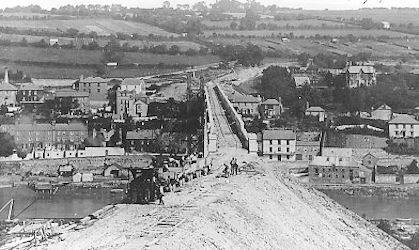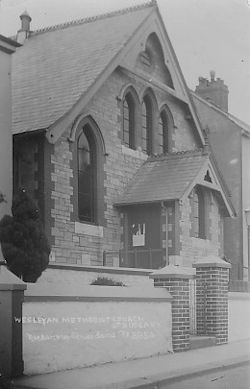|
OLD DEVONPORT
. UK |
||
|
© Brian
Moseley, Plymouth Webpage created: April 14, 2019 Webpage updated: April 15, 2022 |
||
|
RAILWAYS IN OLD DEVONPORT
|
BERE
ALSTON AND CALSTOCK LIGHT RAILWAY CALSTOCK VIADUCT
Calstock Viaduct from the Quay, with part of
the Incline in the foreground. When the Bere Alston and Calstock Railway Light Railway Order was confirmed by the Board of Trade on July 12th 1900, the Order authorised the construction of a viaduct across the river Tamar at Calstock to link the newly constructed Plymouth, Devonport and South Western Junction Railway at Bere Alston Station with the old East Cornwall Mineral Railway line at a point above the village of Calstock. This would then enable trains, both freight and passenger carrying, to travel through from Kelly Bray, or Callington Road Station, to Bere Alston and on to Plymouth or London.
View from the Bere Alston side of the Calstock
Viaduct under construction. Messrs William Robert Galbraith (1829-1914) and Richard Frederick Church (1839-1923) were appointed as engineers to the project, and as both of those gentlemen were resident in London, Mr C J Coombes was made the local supervising engineer. They accepted the tender from a public works and railway contractor in Liskeard, Cornwall, by the name of Mr John Charles Lang, in the sum of £54,680, which was £20,000 less than their own estimate for the cost of construction. This should have sounded alarm bells but didn't and would cause problems later. His contract was dated March 25th 1904. He began work on the Devon side of the river on April 13th 1904. As the Viaduct was to be built of concrete blocks, Mr Lang first set up a block making base and then he purchased two cable-ways to enable the blocks to be carried across the river as the construction work progressed. They were both in place by October 13th 1904. A total of 11,148 blocks, made of cement, sand and granite chippings, were destined to be used in the Viaduct. Commencing from the Devon bank, there were to be twelve arches, each sixty feet wide, with a smaller arch completing the Cornish abutment. Arches 1 to 6 were entirely on land; arches 8,9and 120 were over the water, and were 110 feet to the apex above the High Water Level. Arches 11 and 12 were on land on the Cornish side.
Calstock Viaduct from the Devon side. The work entailed constructing an embankment on the approach to the Viaduct on the Devon side and for this some 59,300 cubic yards of material were brought in between June 1904 and September 1905. Most of this was carried by horse and cart but during the summer of 1905 Mr Lang leased a small steam locomotive named "Ada". Built and leased by Messrs Thomas Spittle Limited, at Newport, south Wales, she was originally used by the Devon Great Consols Mine on the Devon shore, a little way up river from Calstock. An 0-4-0 saddle tank, she had a very small working pressure and had difficulty coping with the 1 in 40 incline on the Calstock side of the river so that on December 11th 1906 she was joined by another, more powerful, 0-6-0 locomotive, "Blanche", previously used by Messrs Relf and Pethick on the construction of the Plymouth, Devonport and South Western Junction Railway. In October 1905 the decision was taken to convert the entire East Cornwall Mineral Railway and the new Bere Alston and Calstock Light Railway to the standard gauge and Colonel Holman Frederick Stephens was employed as Associate Engineer to undertake that task. The first arch was keyed in on May 24th 1906 and arch 12 on May 11th 1907. Cornwall was now joined to Devon at a third point on the river. On August 8th 1907 the first load of spoil was actually run across rails laid on the floor of the Viaduct, which had taken 3 years and 2 months to erect. A new feature was now added alongside arch number number 11, an 113 feet tall wagon lift. Designed by Messrs Galbraith and Church for lowering loaded wagons of stone down to the quay, it was built by Messrs Head, Wrightson and Company, of Thornaby, Teeside. The Viaduct, which is officially 800 feet long and 120 feet high, was opened to public traffic when the new line as officially opened on Monday March 2nd 1908. It might be mentioned that the Viaduct was guarded by the local Home Guard during the Second World War. It is, of course, still used by the trains from Plymouth Station to Gunnislake Station.
|
||


